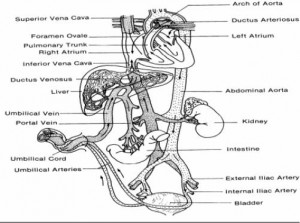As the placenta acts as the intermediary organ of transfer between the mother and fetus, fetal circulation differs from that required for extrauterine existence.
The fetus receives oxygen through the placenta because the lungs do not function as organs of respiration in the uterus.
To meet this situation, the fetal circulation contains certain special vessels that shunt the blood around the lungs, with only a small amount circulating through them for nutrition. See figure 2-9. The following functions occurs:

a. The umbilical vein transports blood rich in oxygen and nutrients from the placenta to the fetal body. This vein travels along the anterior abdominal wall of the fetus to the liver, and at the porta hepatis, the umbilical vein divides into two branches.
b. About 1/2 of the blood passes into the liver and the rest enters a shunting vessel called the ductus venosus that bypasses the liver. The ductus venosus travels a short distance and joins the inferior vena cava.
c. There, the oxygenated blood from the placenta is mixed with deoxygenated blood from the lower parts of the fetal body. This blood continues through the vena cava to the right atrium.
d. As the blood relatively high in oxygen enters the right atrium of the fetal heart, a large proportion of it is shunted directly into the left atrium through an opening in the atrial septum called the foramen ovale.
e. The more highly oxygenated blood that enters the left atrium through the foramen ovale is mixed with a small amount of deoxygenated blood returning from the pulmonary veins. This mixture moves into the left ventricle and is pumped into the aorta.
f. Some of this blood reaches the myocardium by means of the coronary arteries and some reaches the tissues of the brain through the carotid arteries.
g. The rest of the blood entering the right atrium, as well as the large proportion of the deoxygenated blood entering from the superior vena cava, passes into the right ventricle and out through the pulmonary artery.
h. Enough blood reaches the lung tissues to sustain them.
i. Most of the blood in the pulmonary artery bypasses the lungs by entering the ductus arteriosus, which connects the pulmonary artery to the descending portion of the aortic arch.
j. Some of the blood carried by the descending aorta leads to the various parts in the lower regions of the body.
k. The rest of the blood passes into the umbilical arteries which branch from the internal iliac arteries and lead to the placenta.
